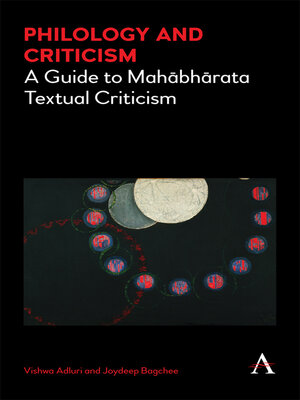Philology and Criticism
ebook ∣ A Guide to Mahābhārata Textual Criticism · Cultural, Historical and Textual Studies of South Asian Religions
By Vishwa Adluri

Sign up to save your library
With an OverDrive account, you can save your favorite libraries for at-a-glance information about availability. Find out more about OverDrive accounts.
Find this title in Libby, the library reading app by OverDrive.



Search for a digital library with this title
Title found at these libraries:
| Library Name | Distance |
|---|---|
| Loading... |
Philology and Criticism contrasts the Mahābhārata's preservation and transmission within the Indian scribal and commentarial traditions with Sanskrit philology after 1900, as German Indologists proposed a critical edition of the Mahābhārata to validate their racial and nationalist views. Vishwa Adluri and Joydeep Bagchee show how, in contrast to the Indologists' unscientific theories, V. S. Sukthankar assimilated the principles of neo-Lachmannian textual criticism to defend the transmitted text and its traditional reception as a work of law, philosophy and salvation. The authors demonstrate why, after the edition's completion, no justification exists for claiming that an earlier heroic epic existed, that the Brahmans redacted the heroic epic to produce the Mahābhārata or that they interpolated "sectarian" gods such as Vis.n.u and Śiva into the work. By demonstrating how the Indologists committed technical errors, cited flawed and biased scholarship and used circular argumentation to validate their racist and anti-Semitic theories, Philology and Criticism frees readers to approach the Mahābhārata as "the principal monument of bhakti" (Madeleine Biardeau). The authoritative guide to the critical edition's correct use and interpretation, Philology and Criticism urges South Asianists to view Hinduism as a complex debate about ontology and ethics rather than through the lenses of "Brahmanism" and "sectarianism." It launches a new world philology—one that is plural and self-reflexive rather than Eurocentric and ahistorical.
|The Critical Edition of the Mahābhārata, completed between 1933 and 1966, represents a landmark in the textual history of an epic with a nearly 1500-year history. Not only is the epic massive (70,000 verses in the constituted text, with approximately another 24,000 in the Vulgate) verses, but in its various recensions, versions, retellings, and translations it also presents a unique view of the history of texts, narratives, ideas, and their relation to a culture. Yet in spite of the fact that this text has been widely adopted as the standard Mahābhārata text by scholars, there is as yet no work that clarifies the details of the process by which this text was established. Scholars seeking clarification on the manuscripts used or the principles followed in arriving at the Critical Text must either rely on informal scattered hints found throughout academic literature or read the volumes themselves and attempt to follow what the editor did and why he did so at each stage.
This book is the first work that presents a comprehensive review of the Critical Edition, with overviews of the stemmata (textual trees) drawn up, how the logic of the stemmata determined editorial choices, and an in-depth analysis of strengths and drawbacks of the Critical Edition. Not only is this work an invaluable asset to any scholar working on the Mahābhārata today using the Critical Edition, but the publication of an English translation of the Critical Edition by Chicago University Press also makes this book an urgent desideratum.
Furthermore, this volume provides an overview of both historical and contemporary views on the Critical Edition and clarifies strengths and weaknesses in the arguments for and against the text. This book simultaneously surveys the history of Western interpretive approaches to the Indian epic and evaluates them in terms of their cogency and tenability using the tools of textual criticism. It thus subjects many prejudices of nineteenth-century scholarship (e.g., the thesis of a heroic Indo-European epic culture) to a penetrating critique. Intended as a companion volume to our book The Nay Science: A History of German Indology (Oxford...







